
Winning in evolving times Strategic imperatives for chemicals companies
18 minute read
06 December 2018
 Duane Dickson United States
Duane Dickson United States- Aijaz Hussain United States
 Robert Kumpf United States
Robert Kumpf United States Sandeepan Mondal United States
Sandeepan Mondal United States
The global chemical industry is riding a wave of strong growth and high margins, but its ability to continue this momentum depends on how it reacts to three long-term developments—advanced manufacturing technologies, digital transformation, and sustainability.
Executive summary
For the global chemicals industry, 2017 has been one of the best years since 2011. The industry registered impressive revenue growth, aggregate industry margins reached all-time highs, most companies recorded healthy cash reserves, and end-markets recovered with demand outlooks showing positive near-term growth promise. Surely, these are good times for chemicals companies, but questions remain about the continuation of this growth momentum in the mid to long term. Three key long-term developments seem to be knocking on chemicals companies’ doors, which could reveal new opportunities if companies respond in a prompt and strategic manner.
The first of these, Fuels-to-Chemicals (FTC) technologies (directly converting crude oil/natural gas to chemicals), hold immense potential to disrupt the future of chemicals manufacturing because of their huge chemicals yields. Anticipating this situation, companies belonging to different categories (see sidebar, “Classifying chemicals companies”) should respond differently. Natural Owners should not only further integrate their petrochemicals assets with refineries (to realize higher synergies) but also tie up with process technology companies, and foray into “Differentiated Commodities” space. And while some Differentiated Commodities companies could explore backward integration through the FTC route, others adopt a service-oriented "solutions" approach to satisfy evolving customer needs. Solution Providers can follow the same strategy as Differentiated Commodities, with a renewed focus on altering their solutions packaging and pricing strategies.
Classifying chemicals companies
To better qualify the strategic responses to these long-term developments, Deloitte looked at global chemicals companies through a different lens in our previously published paper, The chemical multiverse 4.0. This approach divides chemicals companies into three categories: Natural Owners, Differentiated Commodities, and Solution Providers. Each of these categories typically has a different strategic imperative. For instance, Natural Owners—large-scale and vertically integrated—tend to focus more on continuous improvement and operational excellence. Solution Providers generally focus on realizing the power of differentiation that comes from bundling their products with services. Differentiated Commodities often focus on supply chain efficiency, innovation, and cost optimization to thrive in a highly fragmented category.
The second key long-term development, digital transformation, has the potential to metamorphose many aspects of the global chemicals enterprise. While highly diversified companies are already leveraging digital technologies across many functions, the need is to strike a balance between overenthused investments in digital versus viewing digital initiatives as a low-key affair. Companies can perhaps best leverage the power of digital transformation by adopting appropriate digital operating models, recruiting and developing digital talent, investing in advanced and compatible digital technologies, enabling a “digitally mature” culture with support from senior leadership, and watching out for digital disruptions in end-markets. Successful use of digital technologies can also enable companies to leapfrog between categories. Though the category to which the company belongs may decide the scope and scale of digital transformation, chemicals enterprises should always strive to envision novel uses of digital.
The third key long-term development concerns sustainability and the circular economy. Chemicals companies can be part of the solution here by not only helping to solve sustainability challenges faced by end-use industries but also by capturing new opportunities. Apart from investing in new technologies and developing new materials, chemicals companies should work with suppliers, regulators, and customers to enable solutions for solving “ecosystem-wide” issues related to energy and material efficiencies and develop newer ways of doing business—for instance, exploring new service-heavy business models such as chemical leasing, owning the entire circular economy loop, redesigning products and processes with customers, and establishing dedicated supply chains for advanced materials. Barriers to solving sustainability challenges can be overcome by choosing a starting point that is not beset with inertia. For instance, Natural Owners will likely find it easier to integrate technologies enabling energy capture, storage, and use in their daily operations. Differentiated Commodities might invest in recycling technology and infrastructure to own the entire circular economy loop. Solution Providers can provide packaged solutions to sustainability issues without even owning the required product, technology, or service.
It remains to be seen how these three key long-term developments impact the global chemicals industry and the three categories. We hope that through this article, we not only cover the potential impact but also the plausible strategic responses to these long-term developments, which will likely change the entire global chemicals industry landscape by 2030.
Latest growth story hides impending structural changes
Growth in global GDP is on a positive track, manufacturing production has gained momentum, and global chemicals trade has picked up.1 The global chemicals industry crossed the US$4 trillion mark in shipments in 2017, with margins stabilizing and revenue growth for top chemical companies picking up steam (see figure 1). There is undeniable evidence of near-term growth momentum, and many chemicals executives are also upbeat about the industry’s future.2 But will this momentum continue in the mid to long term?
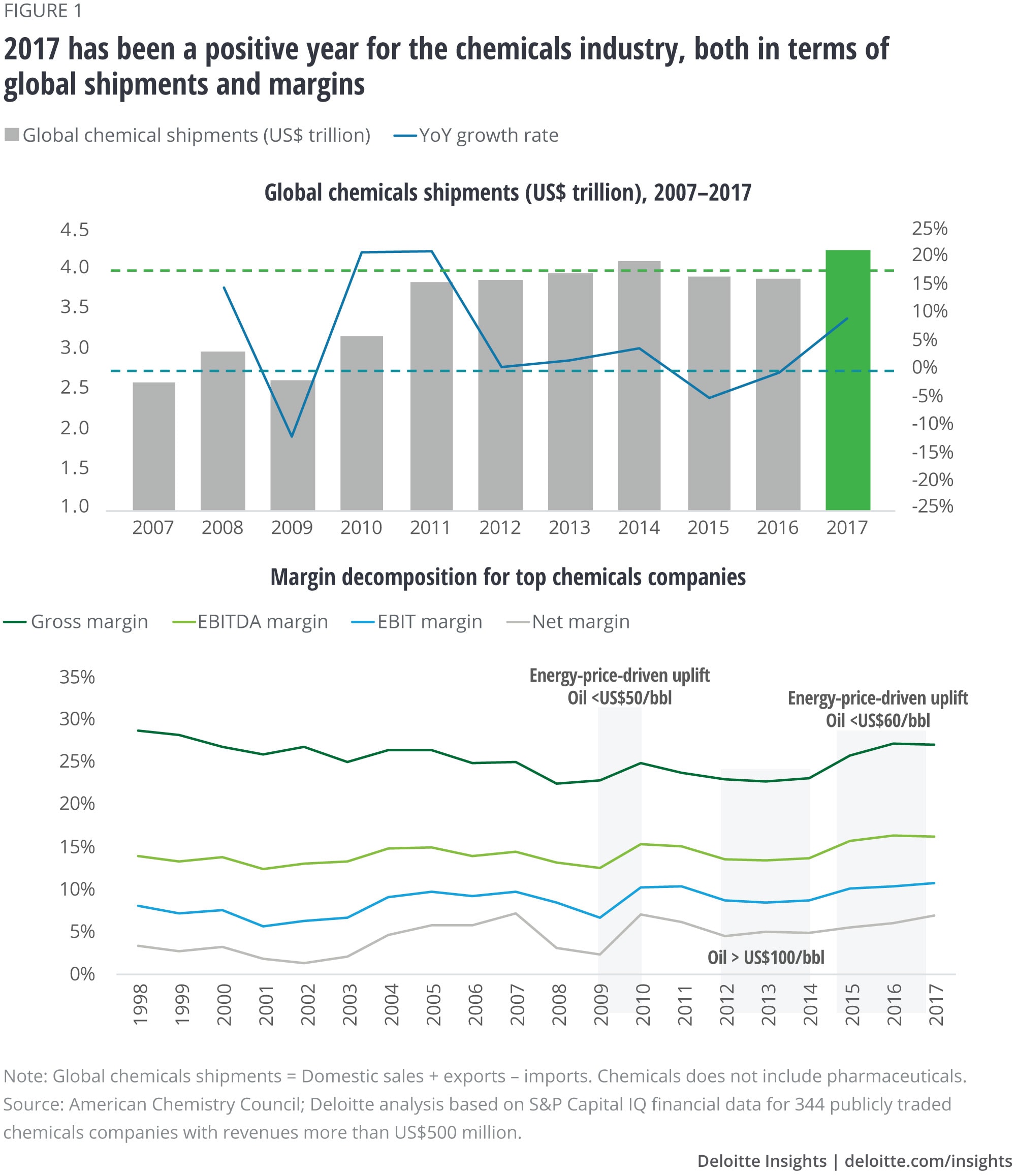
The current trends point toward a global chemicals industry that will continue to outgrow GDP growth, driven by middle-class growth in emerging economies and substitution of traditional materials. But a few developments are rendering the long-term growth outlook for the global chemicals industry uncertain. Traditional approaches, though important and still the core of business strategy, may be less effective. The next phase of growth is expected to come from proactively strategizing in response to these long-term developments.
It also should be kept in consideration that the chemicals industry remains cyclical—the strong margin (and revenue) growth reflects a robust demand recovery in end-markets. Strategizing in response to key long-term developments could involve an unflinching focus on maintaining these strong margins, regardless of the nature of the business cycle. Though these margins will differ by the level of exposure to maturing end-markets, chemicals companies cannot thrive without affecting major portfolio shifts, either through acquisitions or divestitures.
What the “multiverse” approach reveals about the current state of the chemicals industry
In our previously published paper, The chemical multiverse 4.0, we introduced a segmentation approach to clarify the current standing of global chemicals companies. Simply put, chemicals companies were measured on two dimensions: the financial resources at their disposal and their ability to generate returns using those financial resources. This gave rise to four distinct strategic groups that we called: Strategic Leaders, Strong Options, Middle Ground, and Limited Options. Each group has its own unique characteristics but overall, while the former two are financially strong and have a large scale and scope, the latter two have fewer financial resources and suffer from relatively lower business performance.
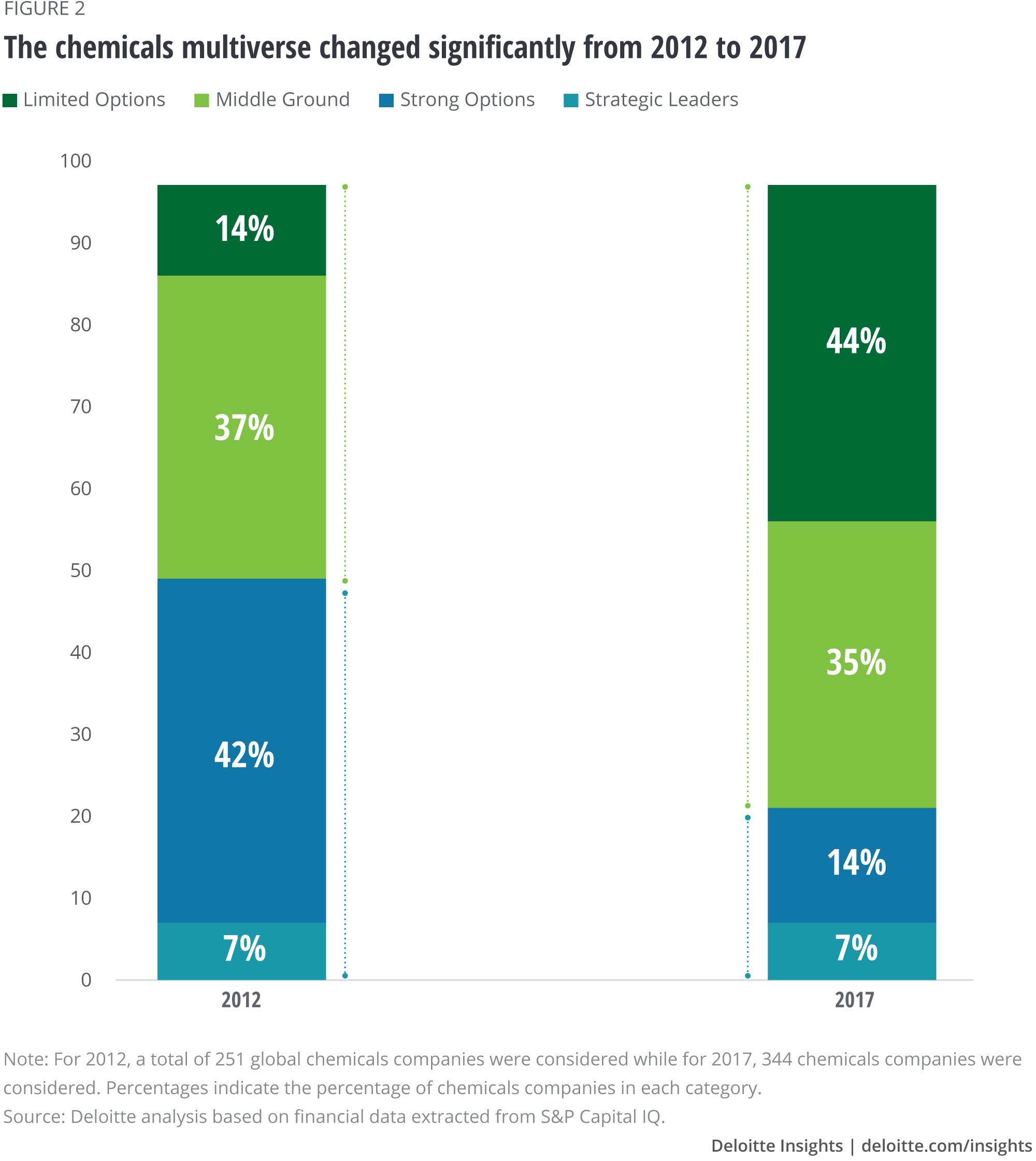
Though the percentage split of these four strategic groups (in terms of number of chemicals companies belonging to each category) have changed significantly in 2017 (see figure 2), the overall financial performance of each of these categories have gone up. For instance, though the number of Strategic Leaders and Strong Options companies combined comprised 49 percent of all companies in 2012, and this percentage dropped to 21 percent in 2017; these sets of companies have performed better (in 2017 vs. 2012) when it comes to "Financial resources availability" and "Financial returns." Another key trend to notice is that the greatest gains in financial resources and returns have happened to Middle Ground and Limited Options companies, rather than to Strategic Leaders and Strong Options. This indicates that while the strong are not necessarily getting stronger, the weak are beginning to inherit the chemicals industry. In other words, the relative difference in performance is shrinking between categories.
Evolving business models, new prerogatives
Many factors are leading most chemicals companies to return to the “core” of their businesses, at least in the short to midterm.3 They are beginning to have dedicated, focused product lines, services, and segments without spreading themselves too thin, likely due to several reasons: shareholder activism, which has forced companies to refocus on their key assets and businesses;4 governments’ anti-monopoly stand, which is forcing them to divest their assets and operations across regions, postmerger;5 cost rationalization, especially for commodity and diversified chemicals companies; and maturing returns on sales.6
Accordingly, all global chemicals companies can be viewed through the lens of evolving business models and can be segmented into Natural Owners, Differentiated Commodities, and Solution Providers (see figure 3).
With creating added customer value as the new mantra, these three categories generally signify three different strategic directions. For instance, Natural Owners, which are mostly state-owned, large-scale, and vertically integrated enterprises, often focus on operational excellence and continuous improvement, and sometimes also explore offering their core products to different customer segments. Solution Providers, on the other hand, typically realize the power of exceptional differentiation, which comes from combining tangible products with intangible services into inimitable solutions. Differentiated Commodities tend to follow a strategy that lies somewhere between that of Natural Owners and Solution Providers.
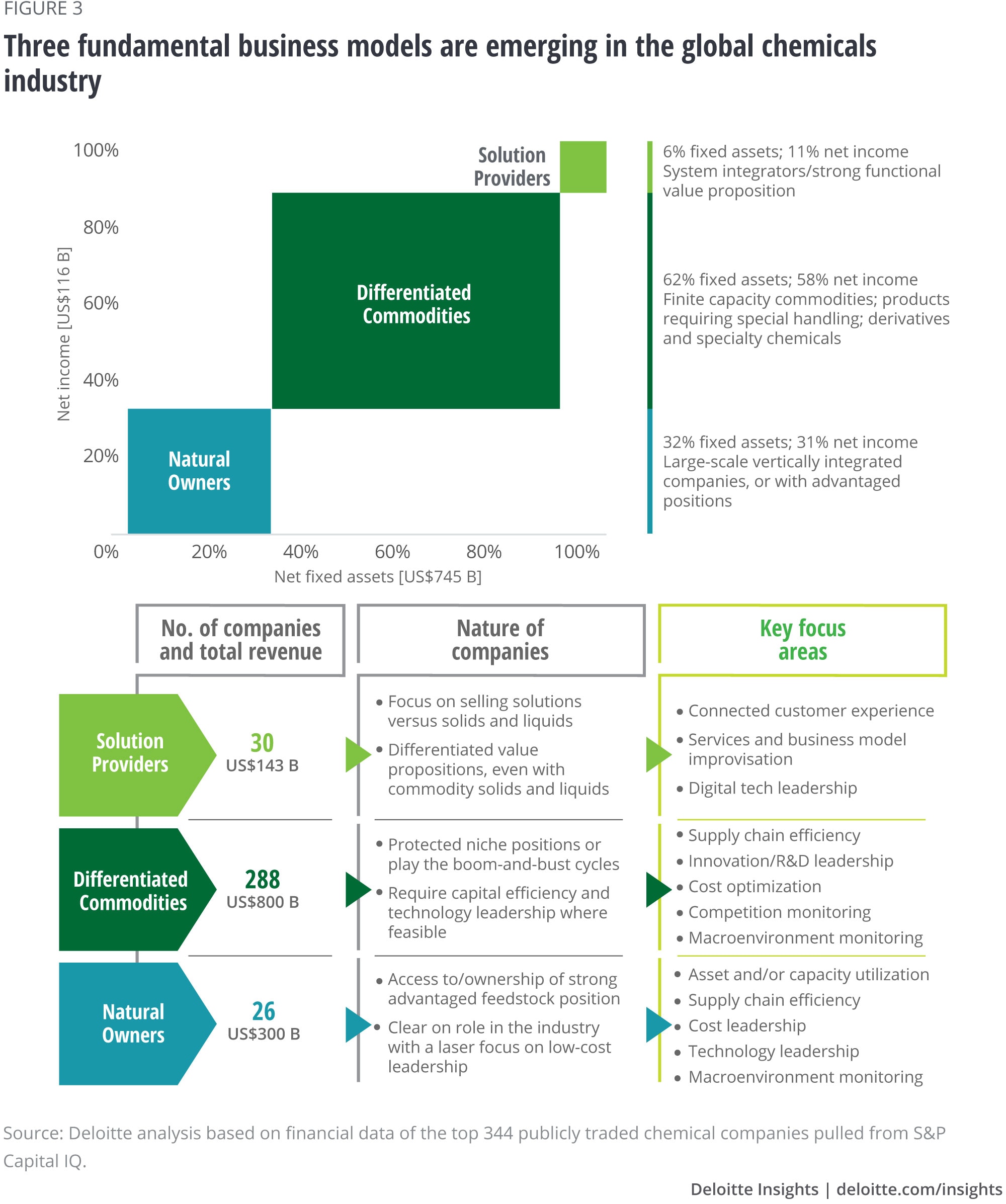
While no chemicals company would be exclusively focused on a single strategic trajectory, there is an overarching approach that determines the strategic path of that company. Based on that overarching approach, we have tried categorizing chemicals companies into these three categories (see figure 3). In the rest of the article, we will discuss strategic imperatives of these three categories in response to the three key long-term developments.
Fuels-to-Chemicals (FTC): The potential future driving force behind chemicals production
Many advanced manufacturing technologies are gradually changing the scale and scope of chemicals production and operations. The most important of these is the Fuels-to-Chemicals (FTC) technology, which encompasses technologies like Crude-Oil-to-Chemicals (COTC) and Oxidative Coupling of Methane (OCM) under its umbrella. These technologies enable the direct conversion of crude oil or natural gas to chemicals, skipping the usual steps in refining or gas processing—resulting in huge chemicals yields. For instance, the COTC technology will likely result in 40–80 percent of chemicals yield per barrel of oil—and huge capacities for some basic chemicals.7 Currently, COTC complexes are mostly emerging in China and the Middle East (see figure 4).
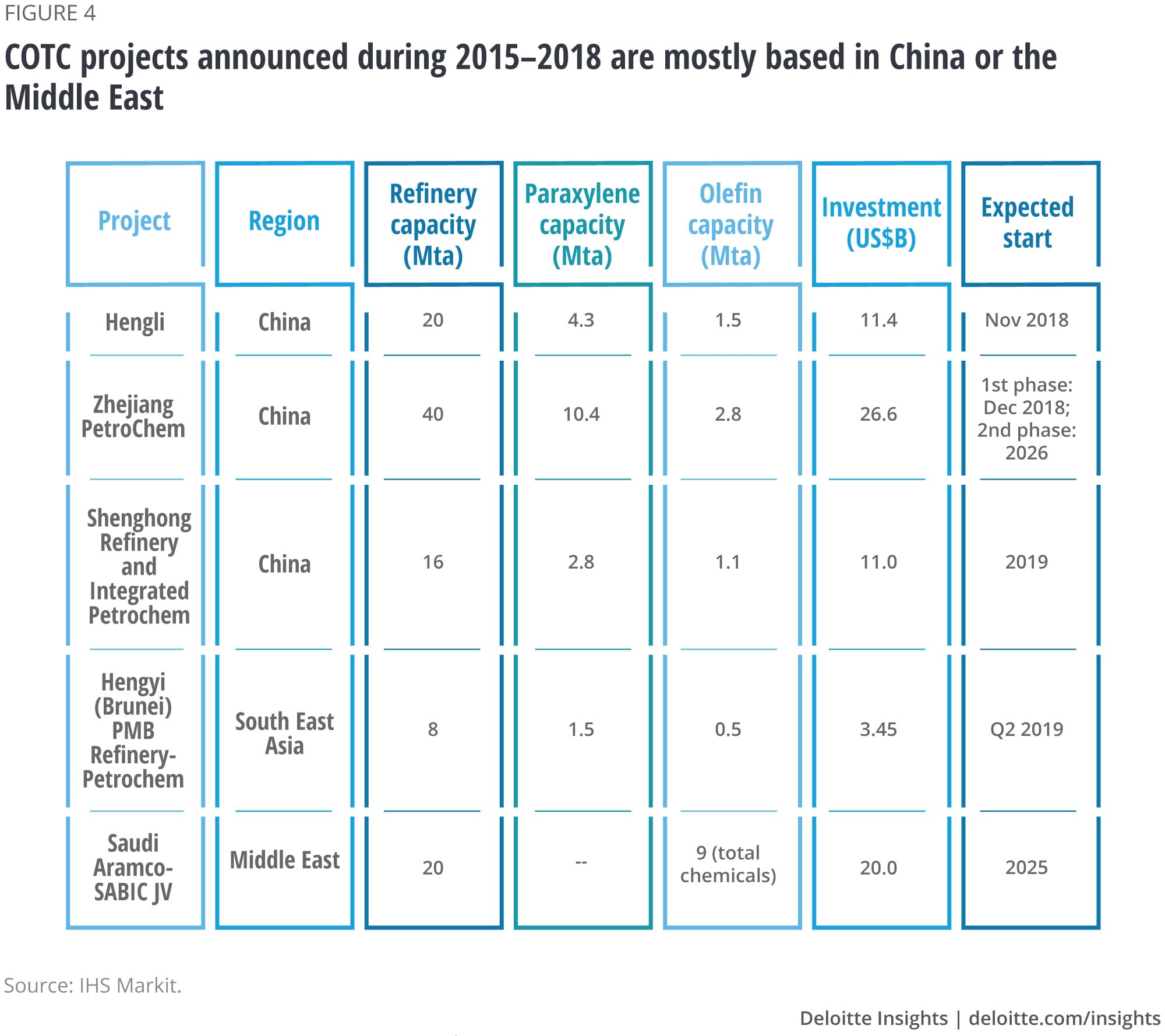
Motivation to build such complexes likely stems from the fact that future annual average growth in petrochemicals is expected to be around 4 percent, while that for transportation fuels may be lower, at around 1 percent.8 Due to this, many companies having the financial muscle, including major integrated oil-and-gas companies, may likely pursue the FTC route to chemicals production.
Apart from FTC technologies, there are others, such as Coal-to-Olefins (CTO), Methanol-to-Olefins (MTO), and Propane Dehydrogenation (PDH), which are already implemented at commercial scale and seem to be redefining regional dynamics when it comes to chemicals production and trade. However, even with a few companies adopting the FTC route to chemicals production, technologies such as CTO, MTO, and PDH might get pushed to the sidelines.
The effect of FTC on petrochemicals capacity growth and utilization will most likely be felt post 2025. Until 2025, despite several capacity-addition announcements by prominent players through the traditional routes, there will likely be capacity build-up delays.9 Also, there is an increasing trend of refinery–petrochemicals integration, especially in Asia.10 Though the traditional route of refinery–petrochemicals integration might directly compete with FTC complexes, both will likely thrive depending on regional feedstock availability, process economics, end-market demand dynamics, and ownership structures.
In view of these potential developments, companies should consider certain strategic imperatives, outlined in figure 5. Right now, FTC is mostly pursued to reduce the import dependency of heavier basic chemicals—as is happening in China to reduce dependency on imported aromatics such as paraxylene. By 2030, we may likely see more FTC complexes geared toward producing light olefins such as ethylene and propylene. Again, this would depend on regional feedstock positions and capital-efficiency paradigms. Also, by 2030, integrated oil and gas companies could demonstrate more market power than before since they already have a secure position in crude oil and natural gas—the key raw materials for FTC technologies.
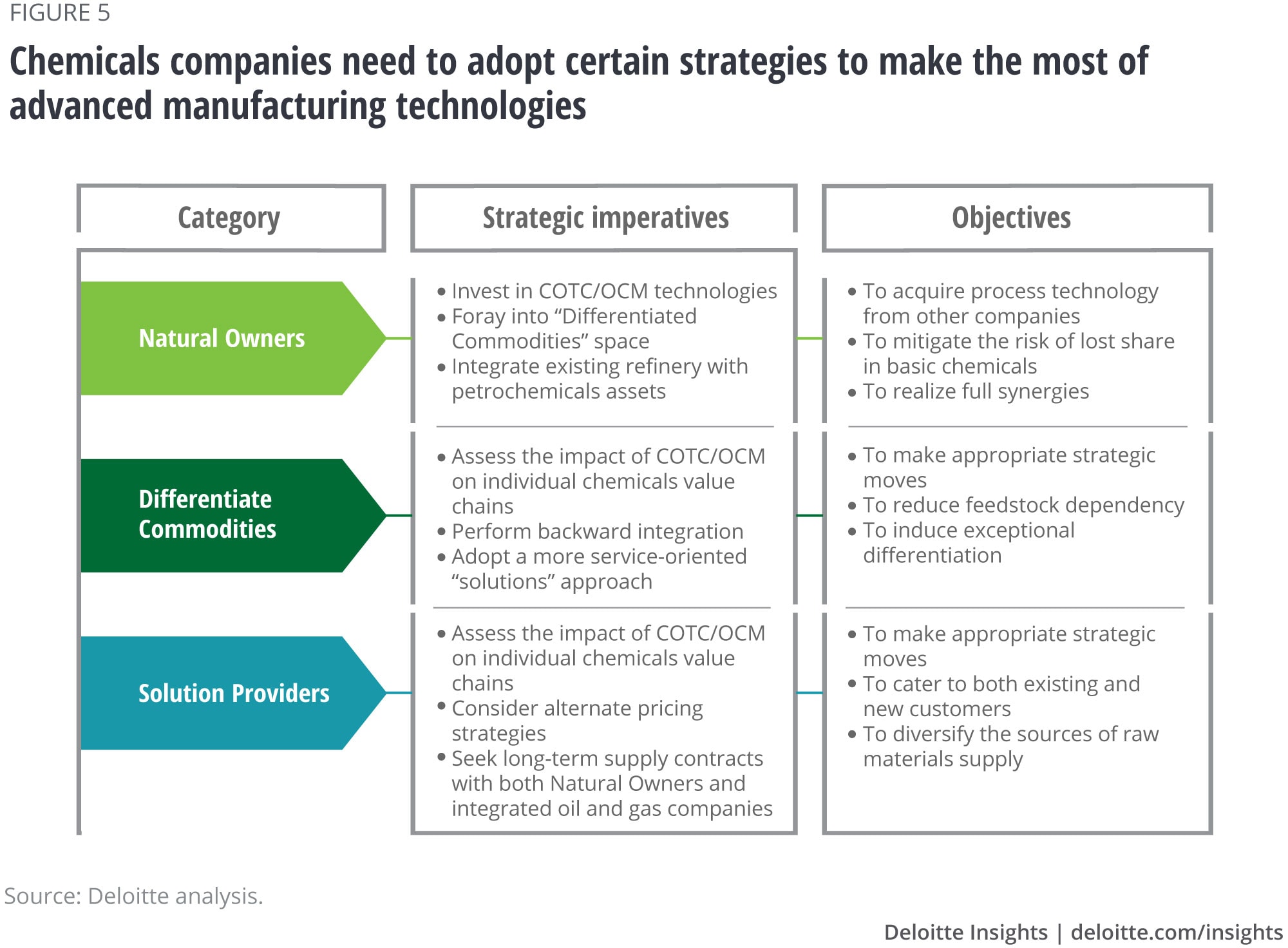
Digital transformation: Optimizing everything from manufacturing operations to organizational processes
Digital technologies are currently used to optimize manufacturing operations, supply chain and logistics, R&D, sales and marketing, HR processes, etc. in many chemicals companies (see figure 6). Anecdotal evidence suggests that the potential of using digital to achieve the next frontier of efficiency is endless—theoretically. However, many companies have suffered from the digital “curse” since they moved too quickly with their digital efforts. These companies went on a spending spree only to see either meager returns on their digital investments or returns which didn’t come through quickly enough.11 The result was eventual scale-back of digital initiatives and downsizing of proposed digital investments.
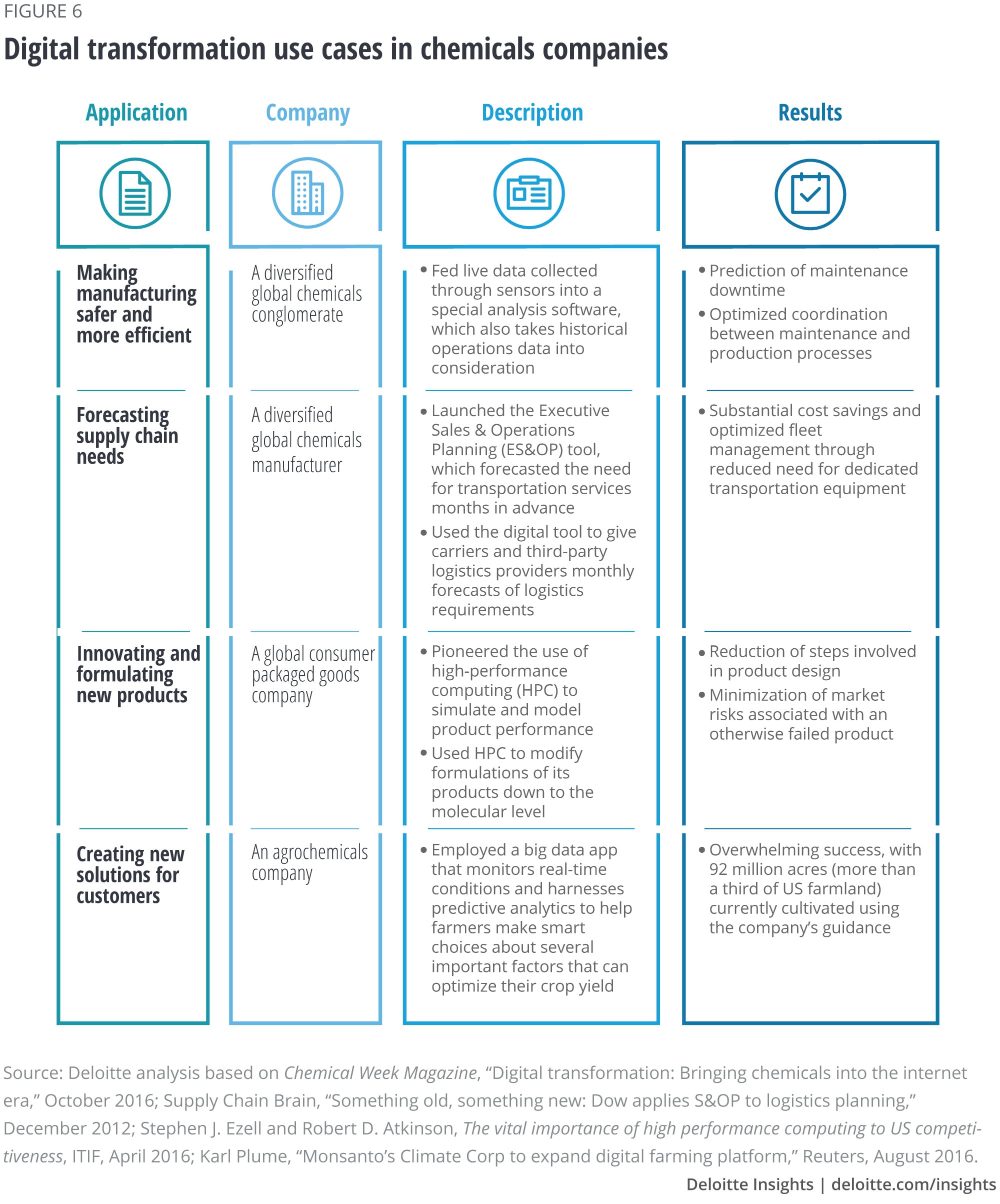
On the other hand, some chemicals companies have shied away from investing heavily in their digital efforts—they can be termed as “too cautious.” Most cite several barriers, including a lack of a convincing business case for digital and half-hearted support from senior executives,12 for their lackluster investments in digital initiatives.
So, how should chemicals companies go about leveraging the power of digital without teetering between these two extremes?
- Accommodate digital initiatives by adopting appropriate operating models: Digital will likely offer different opportunities and benefits to different chemicals segments. For example, a specialty chemicals company could benefit more if it utilizes digital to formulate new products and/or reduce time-to-market, rather than investing in digital to gain higher asset utilization rates. To maximize the chances of success, chemicals companies should adopt a digital operating model that is best suited to their digital maturity and market readiness.
- Recruit and develop digital talent: The future of workforce in chemicals is expected to increasingly be determined using digital technologies within organizations. Digital can act not only as an enabler for attracting a more agile workforce, but also cause chemicals enterprises to hire, develop, and retain highly skilled talent.
- Invest in advanced digital technologies: These technologies should integrate well and enhance the functionalities of current systems. Chemicals companies should move away from monolithic enterprise resource planning (ERP) structures to more integrated platforms that enable real-time visibility, higher computing power, cloud-based architectures, and advanced analytics capabilities including artificial intelligence and machine learning.
- Enable a “digitally mature” culture with support from senior leadership: Primary evidence suggests that digitally maturing organizations have cultures that actively encourage employees to take calculated risks, be agile, and collaborate better.13 Senior leadership in chemicals organizations can proactively espouse such a culture. Evidence also points to the fact that future digital initiatives will increasingly be driven by the C-suite, instead of an IT or digital function.14
- Watch out for digital disruptions and leverage digital in newer ways: Chemicals companies should not only look at new areas in which digital can add the most value (e.g., customer engagement), but also how they can further strengthen their core businesses using digital (e.g., asset utilization). They also should pay attention to digital disruptions happening in their end-markets and how those can impact their businesses.
Certain segments that are closer to the end-consumer might be more exposed to digital disruptions than others. And accordingly, these segments should take a more proactive approach to digital transformation—with the inadvertent focus on meeting or exceeding their customer expectations. For example, a paints and coatings company (i.e., a Differentiated Commodities company) could provide paint services to its end-consumers through an immersive in-store experience that leverages the power of augmented reality (AR). A water-treatment company (i.e., a Solution Provider) could monitor the water quality for its industrial customers using its own customized Internet of Things (IoT) systems, and accordingly provide highly customized solutions based on a “performance pay” model. Similarly, the use of blockchain to manage transactions across suppliers, JV partners, subsidiary companies, and vendors can enable a Natural Owner to reduce fraud and error across the supply chain and save costs for all its stakeholders. An agrochemicals company could bundle its crop protection products with a platform (an app or website) that would convey vital information (related to weather forecasts, crop yields, seeds and fertilizers, etc.), and sell it to farmers (see figure 7).
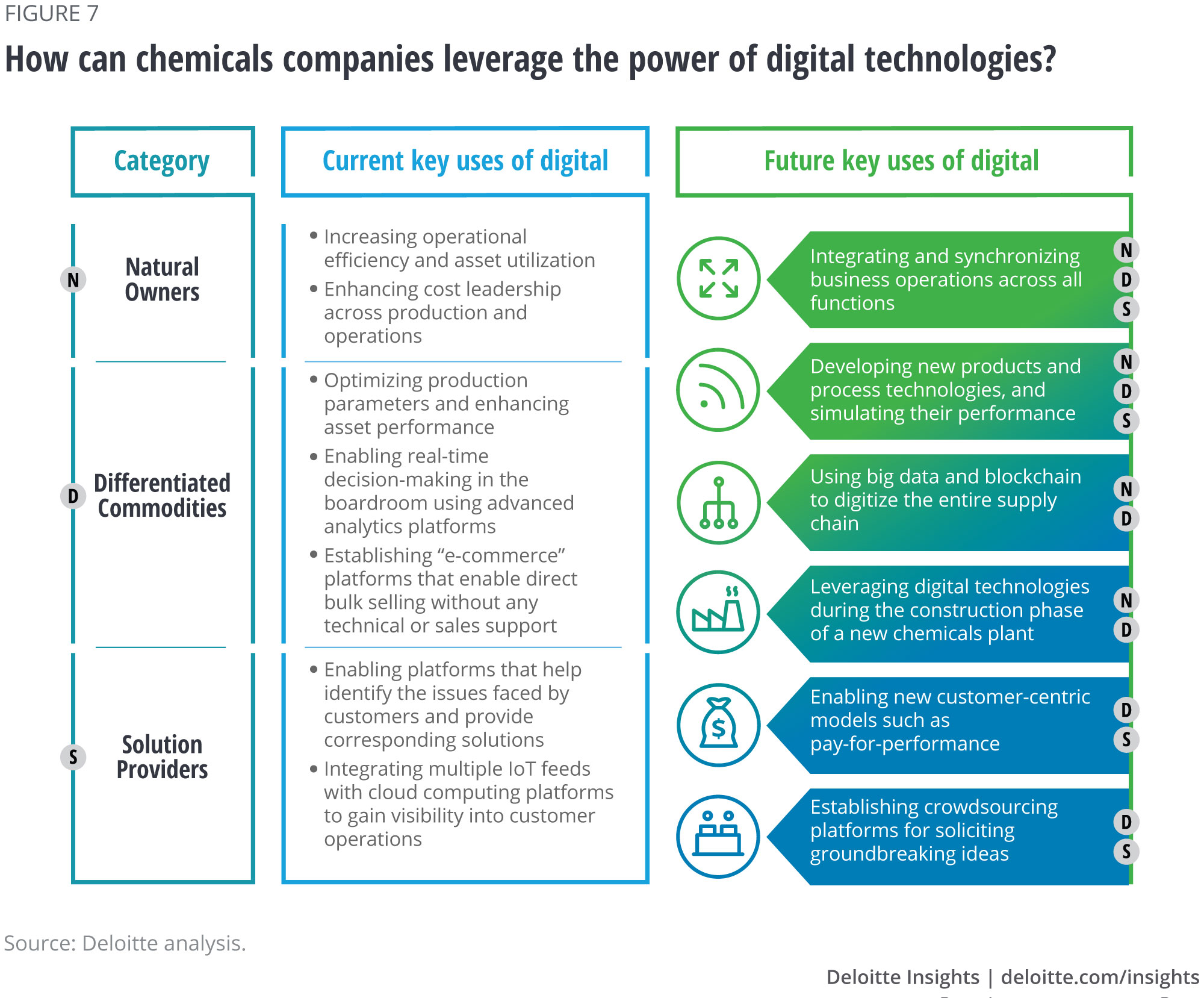
It can be gleaned that digital technologies can help chemicals companies leapfrog categories. For instance, the paints and coatings company from our previous example would clearly leverage the power of AR to transform itself from being a Differentiated Commodities company to a Solution Provider. Also, digital helps them in not only transforming their business models but also in gaining real-time insights on the progress of such transformation efforts.
Sustainability and the circular economy: Creating new opportunities for chemicals companies
Ideal sustainable practices enable nearly closed-loop systems with minimum waste, highly efficient energy flows, and constant material recycling and reuse. If successfully replicated in large-scale settings, it translates to a circular economy where almost everything gets used and nothing goes to waste (see figure 8). A futuristic vision of a true circular economy typically involves a minimized role of fossil-fuel-based materials, higher contribution of nontoxic bio-based materials and renewable energy, elimination of recycling and waste disposal, and service-heavy business models.15 Realizing this vision of a circular economy can lead to billions in economic benefits ranging from substantial net material savings to higher innovation and job growth.16
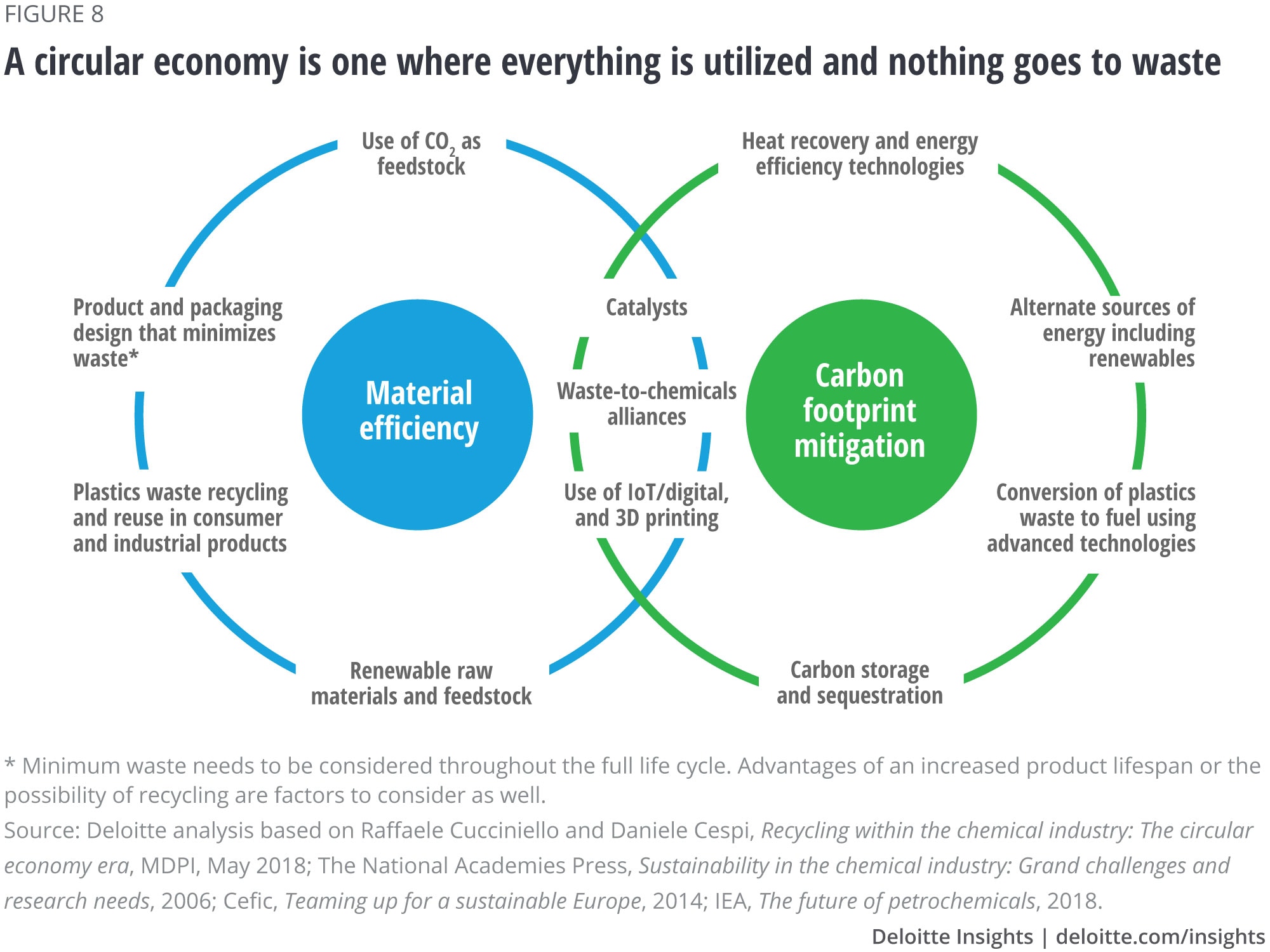
Many end-use industries are aspiring to reach the state of the circular economy, but results remain unclear due to varied challenges.17 Evolving regulations and consumer activism are causing many end-use industries—and even some governments—to look for alternative solutions to these challenges.18 For example, the Chinese Government's plastics waste imports ban (which took effect in 2017) is already compelling developed economies (Europe and the United States) to increase recycling rates, set up better plastics waste collection mechanisms, and institute other policies to counter the plastics waste challenge.19
Future of mobility: A key element of sustainability in chemicals
Based on the substantial evidence that changes associated with the future of mobility will continue to accelerate, it is unlikely to relent and settle into something incremental or linear. Converging trends such as social change, connectivity, smart materials, and digital technologies are fundamentally reshaping the way people and goods flow—a transformation of greater magnitude than the world has experienced in a century. And for chemicals and materials companies, it could dramatically alter their relationship with the broader transportation industry. Each of the key dimensions of the future of mobility—shared transportation, self-driving cars, and electric vehicles—could significantly affect chemicals and materials companies’ business. These shifts also can be considered in the context of sustainability. Deloitte’s analysis (Scott Corwin, et al., Forces of change: The future of mobility) points to a likely increase in total miles driven via broad use of more convenient and cost-effective ridesharing services with a concurrent decrease in vehicle builds as individual vehicle utilization increases significantly. Incentives will align around a lightweight, highly energy-efficient fleet of shared vehicles. Polymer and composite solutions will continue to lead strategies for durable yet lightweight engineering materials.
Among the most sustainable forms of transportation is an electric vehicle (EV) tied to a renewable-energy-based grid. Both technologies require, and will be advanced by, products of the chemicals and specialty materials sectors. Examples include advanced battery materials, high-voltage-resistant engineering thermoplastic connectors, advanced composite bus bodies, specialty coatings for wind turbine blades, and fire-resistant fibers to protect EV passengers from (albeit rare) battery-pack failures. Of course, sustainability approaches such as total lifecycle analysis of materials require full consideration of raw material and energy inputs in the production and disposal of materials. As participants in a process industry, chemicals and materials companies have long invested in technology research with the goal of reducing total material and energy conversion costs. These same skills and investments can be applied to improving the sustainability of materials and processes.
All three shifts in the future of mobility (shared usage, autonomy, and electrification) have the potential to increase the sustainability of transportation. Fully harnessing these benefits will require a coordinated approach that will wed the most efficient production processes with use of materials in energy- and resource-saving mobility applications.
Chemicals companies can be part of the solution here—for not only solving sustainability challenges faced by end-industries but also in capturing new opportunities. For example, government targets to reduce CO2 emissions and increase the fuel economy of vehicles have led to higher incorporation of lightweight chemicals and materials in new vehicles. In the construction sector, as companies strive to make buildings “smarter,” they also are trying to incorporate greener construction materials.20 In the packaging sector, the focus is on making packaging materials biodegradable and re-usable.21 In the power & utilities sector, growth of renewable energy resources such as solar and wind is leading to greater production of solar-cell materials and higher use of composites in wind turbine blades. Thus, the role of chemicals and materials is extending well beyond their current functionalities. And though there is long-term demand uncertainty in key end-markets, sustainability presents a huge opportunity for chemicals companies to meet new sources of demand growth (see figure 9).
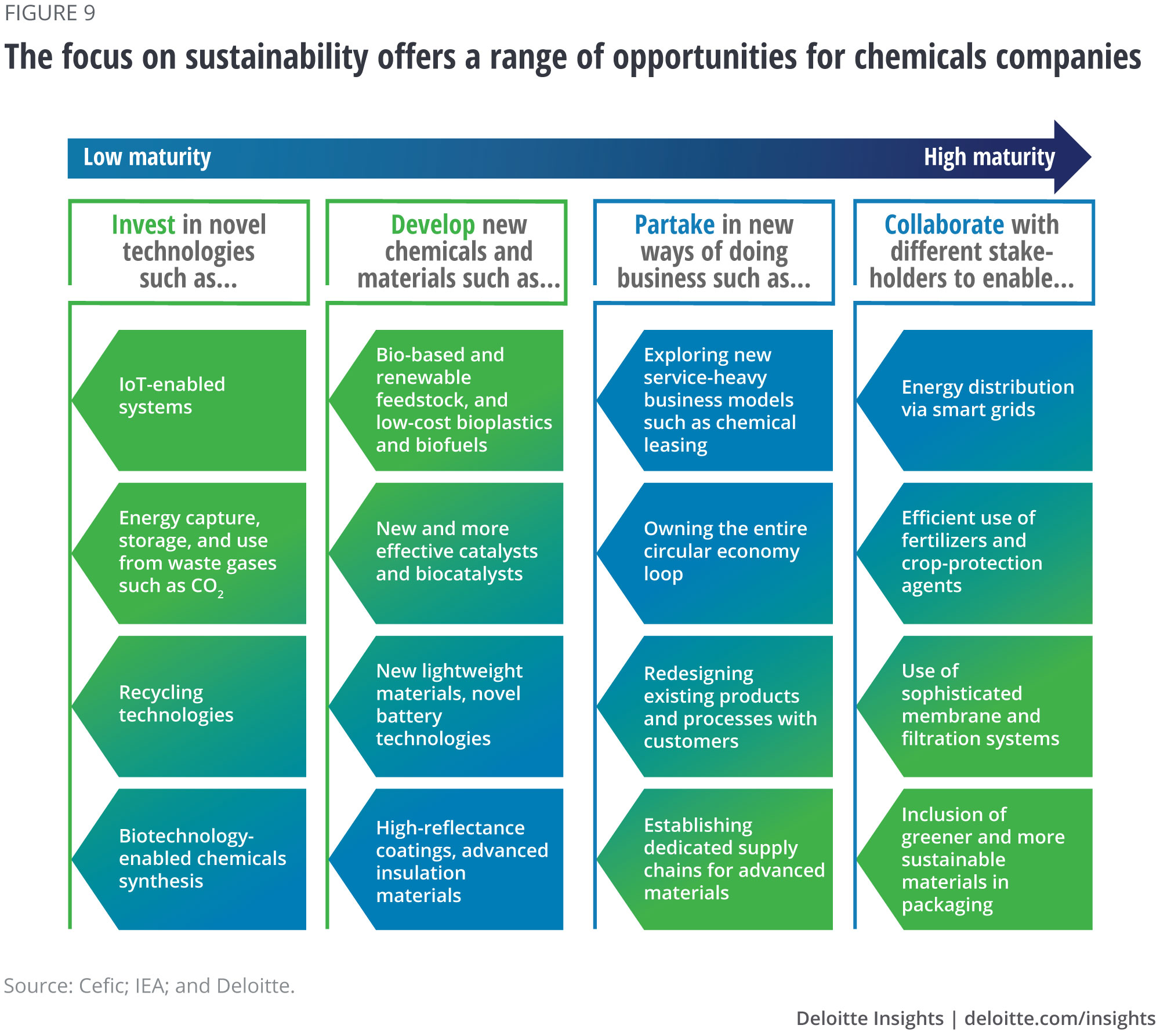
It is highly likely that by 2030, stricter health, safety, and environmental standards will lead companies across end-use industries to innovate and implement new products, processes, and technologies. In some cases, more creative approaches may be required to empower sustainability-related growth drivers, such as inclusion of more women directors on company boards that can lead to better performance on environmental, social, and governance metrics.22 A collaboration or “consortium” approach—with chemicals companies at the center—is also recommended. However, the level of interest to capture the opportunities unveiled by sustainability could differ by category. For instance, Natural Owners with high exposure to commodity chemicals will likely have lower motivation to invest in “sustainable” products and services, as their need for differentiation is low. Yet some Natural Owners can realize the “sustainability” opportunities if they have solutions to enduring issues such as the use of microplastics in cosmetics and multilayer packaging films. However, it is more likely that some Differentiated Commodities companies and almost all Solution Providers could be best placed—and have lower inertia—to take advantage of the opportunities unveiled by sustainability.
Gearing up for the long term
A quick assessment of top companies in each of the categories in terms of their exposure to the three long-term developments and relative preparedness seems to reveal a few distinct trends (figure 10). First, Natural Owners appear most exposed to the impact of Fuels-to-Chemicals technology and the least prepared to take advantage of opportunities unveiled by sustainability. Second, Differentiated Commodities are expected to be most affected by sustainability as the clamor for more innovative solutions to sustainability challenges grows louder; they remain moderately prepared for all three key long-term developments. Third, Solution Providers will likely be most affected by the next wave of digital transformation since they remain closest to their customers.
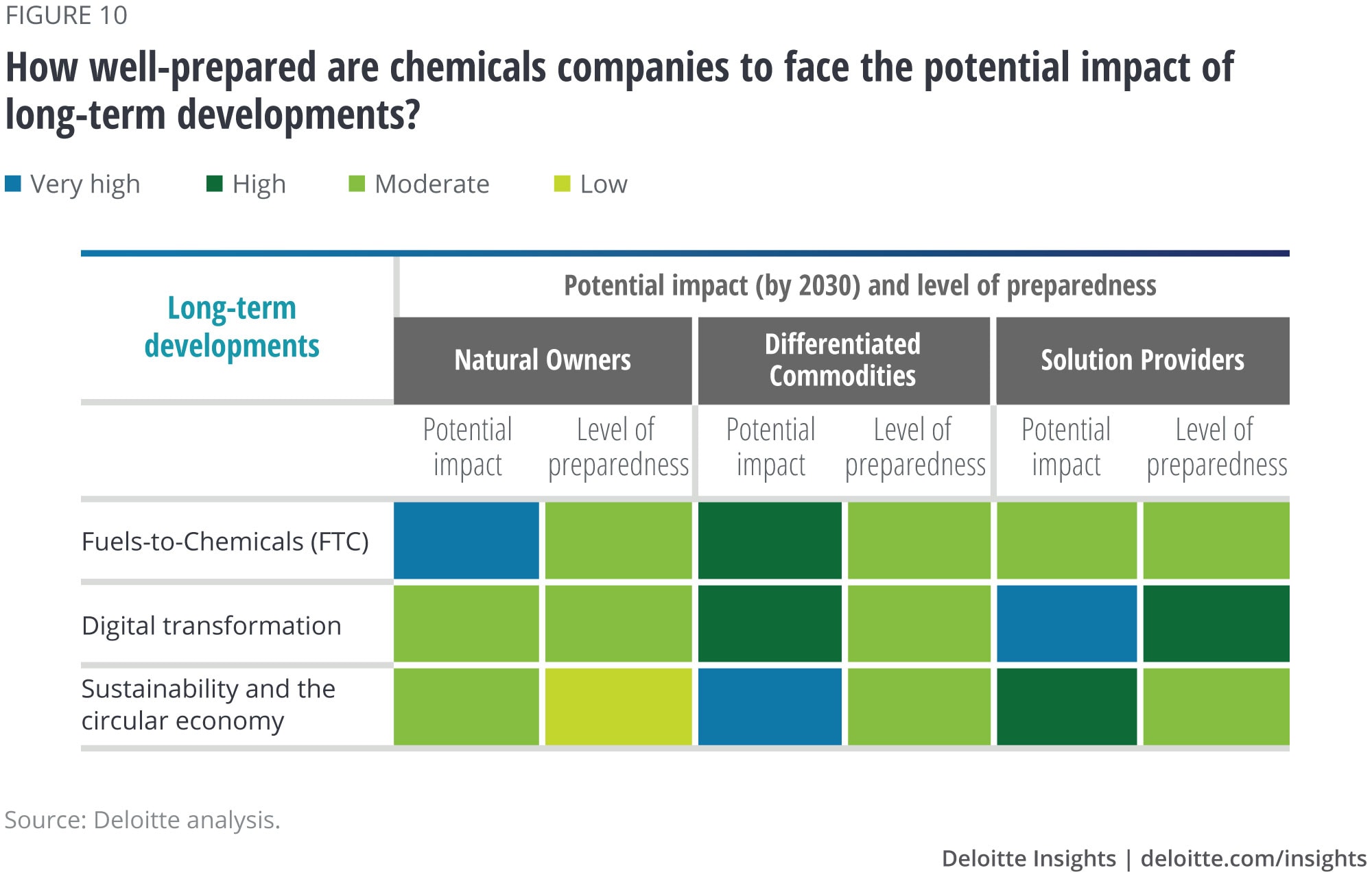
It is obvious that the strategic responses to the three long-term developments highlighted in this paper will vary by the company category. Depending on the benefits of these developments perceived by chemicals companies in these categories, specific company responses will also differ. In Deloitte’s 2018 oil, gas, and chemicals industry survey, chemicals executives listed innovation, sustainability, and advanced technologies as their top strategic priorities.23 This is good news, as these strategic priorities correspond to the three key long-term developments discussed here. But just having the clarity of strategic purpose is likely not enough. Chemicals companies should position themselves well enough to seize the new opportunities arising from these long-term developments. This positioning could require renewed focus on optimizing their products and services portfolio through continued acquisitions or divestitures. Moreover, this positioning should be done in the spirit of making themselves robust enough to successfully navigate the economic down-cycle and maximize profit-making opportunities during the up-cycle.
More insights for Oil, Gas, & Chemicals
-
Making the future of mobility Article6 years ago
-
From bytes to barrels Article7 years ago
-
Refining at risk Article6 years ago
-
US shale: A game of choices Article10 years ago
-
Following the capital trail in oil and gas Article9 years ago
-
Made in America: The economic impact of LNG exports from the United States Article11 years ago










